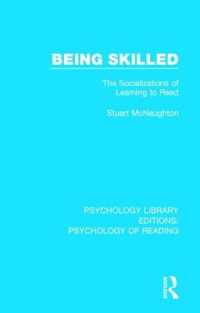- ホーム
- > 洋書
- > ドイツ書
- > Social Sciences, Jurisprudence & Economy
- > Politics, Society, Work
- > political science
Full Description
This second edition of "Sustainable Mountain Development" is a history of the development of mountain environmental awareness from its origins during the Stockholm Conference on the Environment in 1973. This provided intellectual input into UNESCO's MAB Programme, especially MAB-6 (Impact of Human Activities on Mountain Environments), The International Geographical Union's commission on mountains, and The United Nations University's (UNU) mountain project, the latter initiated in 1978. All this research and intellectual activity saw its maturation during the 1992 Earth Summit held in Rio de Janeiro. The major document universally agreed upon was AGENDA 21, with Chapter 13 concentrating on mountain environmental problems which led to 2002 being dedicated as The International Year of Mountains, and December 17th as International Mountain Day.
The research that inspired this book, accompanied by intensive environmental and political activity, was initially propagated by a small group of colleagues that ultimately expanded to a world-wide endeavour. The work was recognised by three awards of the King Albert Gold Medal, two RGS Gold Medals, approved by Her Majesty Queen Elizabeth II, and countless other awards. It led to the founding of the International Mountain Society in 1980 and its quarterly journal "Mountain Research and Development" (1981). The work expanded into subsequent research efforts, including specific assessments of projected major catastrophes such as the status of the potential outbreak of glacier lakes (GLOFs), the impacts of climate warming, and incorporation of the mountain subsistence men and women whose environmental knowledge was enthusiastically recognized. This edition provides a new epilogue, which outlines the considerable changes to world environmental assessment since the establishment of 2002 as the International Year of Mountains, and notes that 2022 has been designated as the International Year of Sustainable Mountain Development.
Contents
Chapter1. Global Mountain Awareness.- Chapter2. An International Mountain Involvement: The Beginnings.- Chapter3. Mountain Strategy in Munich, 1974: On Track to the Himalaya.- Chapter4. Darjeeling: Personal Awakening to High Mountains and Refugees.- Chapter5. Moscow and the Caucasus: The IGU in the Cold War.- Chapter6. United Nations University: Agency with a Mountain Mission.- Chapter7. Himalayan Reconnaissance 1978: Deforestation, Landslides, and Farmers.- Chapter8. The China Connection: Privileged Entry to a Closed Country.- Chapter9. Beyond Lhasa: Opening China to Collaborative Mountain Research.- Chapter10. Breakthrough: Environmental Degradation Theory Overturned.- Chapter11. China Revisited 1985: Yunnan and the Jade Dragon Snow Mountains.- Chapter12. The Mohonk Process: Mobilization of the Mountain Advocates.- Chapter13. Mountain Road to Rio: The UN Earth Summit 1992.- Chapter14. Return to China 1991-1996: Mountain People of Yunnan and Mass Tourism.- Chapter15. Roof of the World: The Pamir, 1999: "A Catastrophe of Biblical Proportions".- Chapter16. Threatened Disasters in the Pamir and Himalaya.- Chapter17. The Evolution of the Mountain Cause.






